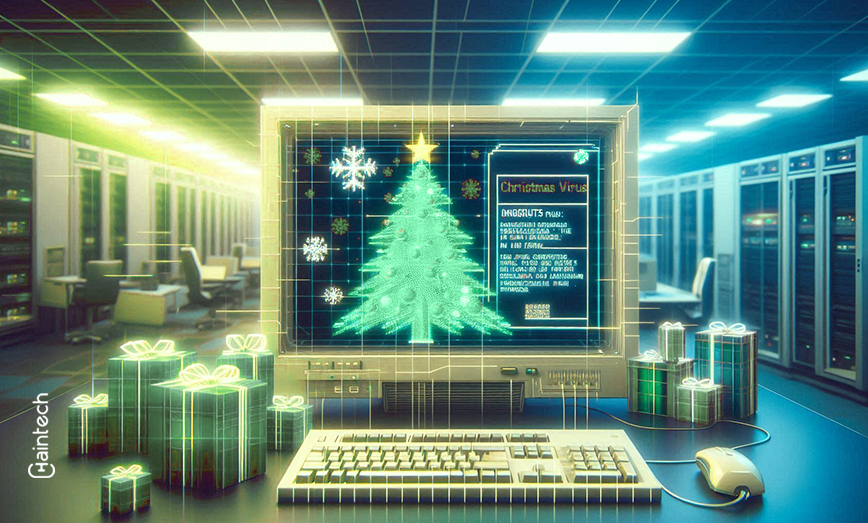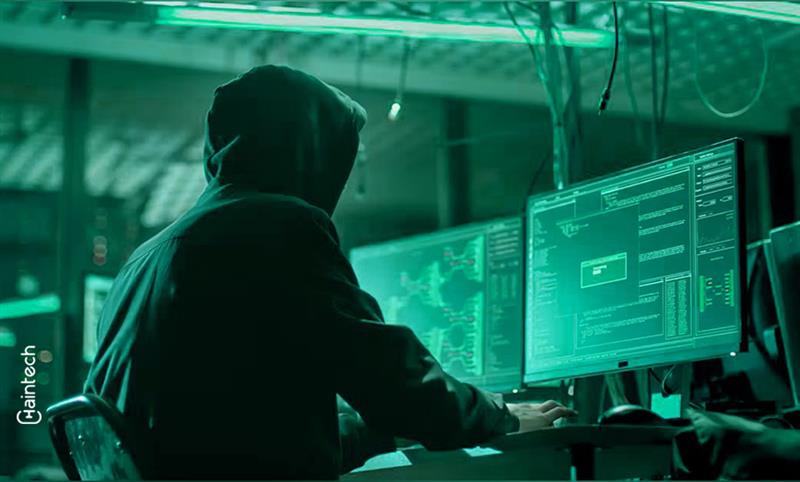1987 Christmas Virus: The First WAN Virus in History

Imagine it’s 1987, and you’re sitting at your desk, working on a big project. Suddenly, a message pops up on your computer screen. It’s a Christmas tree made out of characters. Harmless, right? You laugh, maybe share it with a colleague, thinking it’s just a festive prank. But little did anyone know that this innocent-looking tree was part of the first wide-area network – Christmas virus—the Christmas Tree worm, also known as CHRISTMA EXEC.
This was no ordinary virus. It didn’t steal data or corrupt files. Instead, it clogged networks and overwhelmed systems.
When people realized what was happening, it spread like wildfire across major networks. How did this seemingly harmless virus cause so much chaos? Keep reading to find out.
The Story Behind the 1987 Christmas Virus
The Christmas Virus wasn’t designed with malicious intent, but it left a lasting mark. Written in REXX, a scripting language used on IBM mainframes, this worm spread quickly. The person behind it, “Dr. Chandra,” wasn’t trying to steal or destroy data. Instead, the virus was more like a test of how far a program could spread through a network.
When someone opened the virus, a digital Christmas tree appeared on their screen. It looked fun and festive, and because of this, many users thought it was harmless fun. But behind that cheerful display, the worm was busy. It scanned the system, pulled contacts from the user’s email address book, and sent itself to everyone listed. It was a simple trick, but it worked brilliantly.
People weren’t used to such a threat at the time. No major damage was done, but the virus did something no one expected. It used up a lot of network bandwidth, slowing systems to a crawl. This was one of the first times the world realized how vulnerable networks could be, even to non-destructive programs.
How the Christmas Virus Spread: Simple Yet Effective
The Christmas Virus was clever in its simplicity. It primarily targeted IBM mainframe systems that ran the VM/370 operating system. These systems were popular at the time, especially in large corporations and universities. Once the virus found a way into one system, it quickly spread through the network.
The virus didn’t exploit any major vulnerabilities or complex hacks. It simply relied on users. When people received the message with the Christmas tree, they would execute the program, thinking it was just a fun holiday message. But in the background, the worm would scan their contacts and send itself out to everyone in their network.
Its originality was its method of virus transmission, which utilized the Wide Area Network (WAN), which at the time connected. Since the virus jumped to other systems, it was among the earliest viruses to attack the world.
Lessons from the 1987 Christmas Virus
The Christmas Virus did not inflict any physical harm; however, it taught many things. The first one was how malicious code execution is very simple. It is not abnormal to use one’s computer and open every attachment that comes in without second-guessing the attachment and any programs within it, which seemed innocent.
The other one was about network security. In early 1987, such attacks were not anticipated in many systems. There were no firewalls or sophisticated security measures. Networks were almost non-existent, and after that, outages were inevitable; that is when the virus was unleashed.
One way the virus operated was by causing a lot of waste in order to affect systems without deleting or stealing any information. The virus alone was able to bring down systems by only using up their network capabilities.
How Organizations Responded
| Organization | Response Action | Outcome | Learning from Incident | Year Implemented |
| IBM | Upgraded network security protocols | Improved monitoring of network traffic | Introduced stricter access control | 1988 |
| Universities | Installed network monitoring systems | Reduced spread of network worms | Focused on user awareness programs | 1989 |
| Corporate Mainframes | Updated software patching systems | Improved system resilience | Began regular software updates | 1990 |
| Government Entities | Implemented firewalls | Blocked unauthorized access attempts | Increased investment in cybersecurity | 1991 |
| Tech Companies | Developed antivirus software | Enhanced malware detection capabilities | Laid foundation for modern antivirus programs | 1992 |
How Modern Cyber Security Evolved from the Christmas Virus
Fast forward to today, and cybersecurity has come a long way since 1987. The Christmas Virus was a wake-up call, and it paved the way for many of the cybersecurity practices we now consider standard.
Let’s look at how cybersecurity evolved because of this event.
- Firewalls: One of the most radical changes was the development of firewalls. These are systems situated between a reliable network and the outside world, preventing any possible malevolent incursion.
- Antivirus Software: Christmas Virus exemplified a situation that called for introducing a system that could be used to isolate and prevent viruses from spreading further.
- Regular Updates and Patching: After the virus, organizations realized they needed to keep their systems up to date. Regular updates and patches fix vulnerabilities and ensure that systems stay secure.
- User Awareness Training: The Christmas Virus used social engineering as one of its key tactics. Today, businesses invest in cybersecurity training programs that teach users to recognize and avoid potential threats.
- Intrusion Detection Systems (IDS): While IDS technology was still in its early stages in 1987, the Christmas Virus showed the need for systems to monitor network traffic and detect suspicious activity. Modern IDS systems are now a key part of cybersecurity strategies.
Lessons for Businesses Today
Although the Christmas Virus first appeared more than 37 years ago, its teachings are applicable even today. These days, there are even larger and more threatening challenges, but the characteristics of cyber security remain the same.
Most cyberattacks depend on us making mistakes. Teach workers the right way: don’t click on dubious email links or download suspicious files, and stick to the company’s security procedures. Software weaknesses are a major target on the list of a hackers. Ensure all user systems receive regular updates and the latest enhancements.
Firewalls, antivirus programs, and intrusion detection systems are equally important for every company. They guard against both outside attacks and internal sabotage. Always check your network for any sign of unusual activity. If something were to go wrong, early detection can save a minute problem from escalating into a massive one.
Are We Truly Safe from Future Cyber Threats?
Though no one explicitly intended to carry out any malicious act, the 1987 Christmas Virus has marked a watershed moment in hacking and cyber security. It illustrated that programs that were not intended to be harmful could still cause a lot of damage and that networks needed to be secured at all costs.
Nowadays, companies are under more advanced threats, and more lessons learned from the Christmas tree worm analogy are valid, too. The role of user awareness, network defense, and keeping watch should not be taken too lightly. Technological advancement has taken place, but the core essentials of cybersecurity have not changed: protect, watch, and update.
Staying one step ahead is key, and with the right precautions, businesses can avoid becoming the next victim of a digital “Christmas surprise.”









